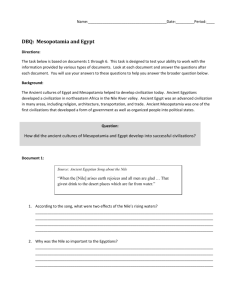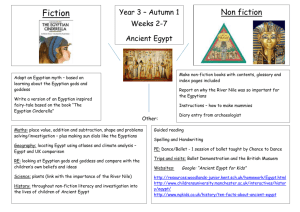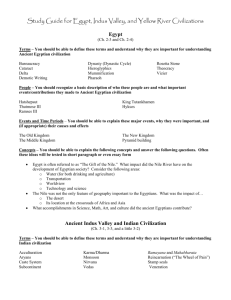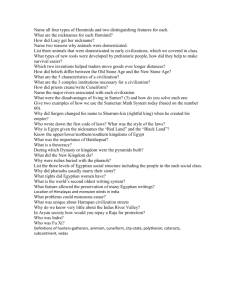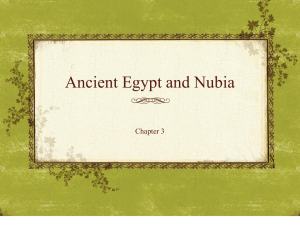Egypt, India, and China
advertisement
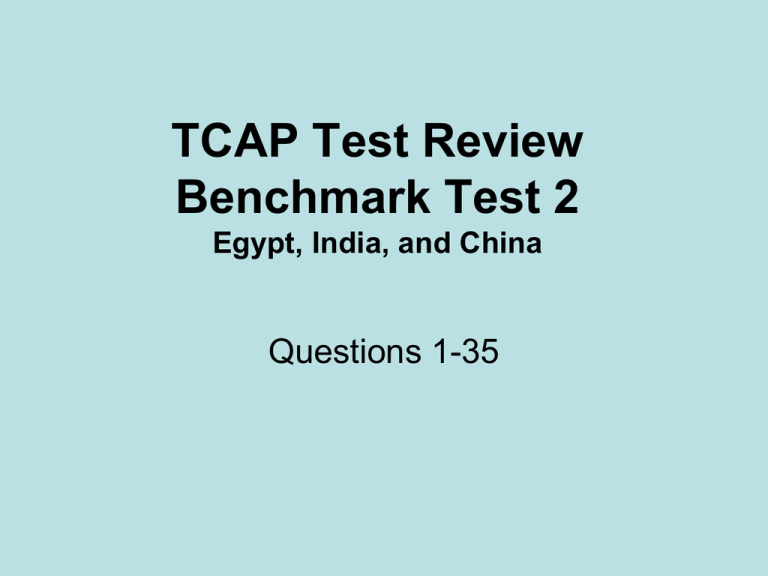
TCAP Test Review Benchmark Test 2 Egypt, India, and China Questions 1-35 1 • The Nile River flooded every year and made the nearby land – A. – B. – C. – D. Impossible to farm. Ideal for farming. Unfit for people to live on. Polluted. 2 • Considering its geography, one thing protecting Egypt from invasion and allowing it to be a strong nation for many years was – A. – B. – C. – D. The flooding of the Nile. Gold from Nubia. Its large navy. The desert. 3 • Because the Nile River empties into the Mediterranean Sea, it flows – A. – B. – C. – D. East to west. West to east. North to south. South to north. 4 • The Egyptian army was very successful against their enemies because the Egyptians – A. – B. – C. – D. Knew the god Horus was on their side. Used elephants. Used bronze swords and body armor. Used better military tactics. 5 • The Egyptian pyramids were – A. – B. – C. – D. Government office buildings. Empty monuments. Tombs for dead pharaohs. Museums. 6 • In order to keep track of growing wealth, the ancient Egyptians developed a system of writing called – A. – B. – C. – D. Cuneiform. Alphabetics. Symbols. Hieroglyphs. 7 • Egyptians predicted when the Nile would flood by using – A. – B. – C. – D. Oracles Astrology Astronomy Herbalism 8 • The great barrier north of India is the – A. – B. – C. – D. Indian Ocean Himalayas Ganges River Indus River 9 • India’s society is divided into social groups that are called – A. – B. – C. – D. Occupations Clans Priests Castes 10 • The religion most associated with ancient India with a belief in karma and reincarnation is – A. Egypt – B. India – C. China – D. Italy 11 • According to the Upanishads, reincarnation is the Hindu belief that – A. Describes the beginning of the world. – B. Explains why people suffer. – C. After death, the soul is reborn in another living thing. – D. There are many gods. 12 • In a caste system, people have to – A. live on common land. – B. following the teachings of the Vedas. – C. do the same jobs as their parents. – D. work for the lord of a manor. 13 • Siddhartha Gautama, a prince of India, began the religion of – A. – B. – C. – D. Buddhism. Hinduism. Christianity. Islam. Siddhartha Gautama Four Noble Truths Path to Enlightenment Nirvana – Lasting Peace 14 • China’s first civilization developed by the – A. – B. – C. – D. Ganges River Huang He River Nile River Tiber River 15 • A government system capable of performing the actions described to the side would most likely have been found in – – – – A. a city. B. a village. C. a farming community. D. a nomadic community •Establishment of laws •Organization of public works projects such as public buildings 16 • Confucius was a(n) _________. – A. – B. – C. – D. Egyptian philosopher Chinese philosopher Indian philosopher Mesopotamian philsopher 17 • Which of the following was an Egyptian pharaoh? – A. Ramses II – B. Constantine – C. Kublai Khan – D. William the Conqueror 18 • Dynasties in China often grew weak because large empires became too – A. rich. – B. powerful. – C. difficult to govern. – D. difficult to conquer. 19 • Buddhism was spread from India to China by – A. – B. – C. – D. The students of Confucius. Europeans. Missionaries. Armies along the Great Wall. 20 • Which of the following did the Chinese invent? – A. – B. – C. – D. Hieroglyphs Paper made from wood pulp Aqueducts Walls 21 • Which ancient civilization is shown on the map? – A. – B. – C. – D. India China Egypt Greece 22 • The Indus and Ganges rivers are located in this country. – A. China – B. Italy – C. India – D. Egypt 23 • The Huang He River and Great Wall are located in this country. – A. China – B. India – C. England – D. Spain 24 • What is the name of the ancient trade route between China and Europe? – A. the Silk Road – B. the Grand Canal – C. the Mediterranean Sea – D. the Mali River Route 25 • Which of the following best describes a barter economy? – A. Items are exchanged for money from other regions. – B. Items are traded for food and goods from other regions. – C. Items are stolen from other regions. – D. Items are made in other regions and given as tribute. 26 • The Mongols, led by Genghis Khan, impacted world history – A. by spreading Christianity to Russia. – B. by building the Silk Road. – C. by conquering China and creating an empire that stretched across Asia to Eastern Europe. – D. by destroying the Japanese Empire. 27 • Which culture produced this painting? – A. Indian – B. Mayan – C. Chinese – D. Arab 28 • Which civilization left records that influenced the way Greeks and Romans understood medicine? – A. Indus – B. Egyptian – C. Chinese – D. Babylonian 29 • How did the Chinese farm their lands? – A. They built terraces along the slope of the mountains to plant crops. – B. They only grazed animals. – C. Chinese farmers were unable to farm because the Yellow River often flooded. – D. They did not farm and purchased food from traders traveling the Silk Road. 30 • This landmark was built in China to protect from invaders. – A. Hadrian’s Wall – B. Constantinople Wall – C. Wall of Jerusalem – D. Great Wall 31 • A scholar could study which epic to learn about early Indian culture? – A. The Aeneid – B. Gilgamesh – C. Mahabharata – D. The Odyssey 32 • One difference between the development of civilizations in India and Egypt was the – A. growth of cities. – B. influence of Hinduism. – C. development along rivers. – D. interaction with the Native American civilization. 33 • Which ancient civilization used hieroglyphics? – A. Egypt – B. India – C. Mesopotamia – D. Sumeria 34 • Which type of ancient community includes: domesticated animals, invention of new tools, and irrigation systems? – A. farming – B. nomadic – C. city-state – D. state 35 • The development of writing in ancient Mesopotamia made possible the first visible – A. legal codes. – B. private businesses. – C. national armies. – D. organized religions.

